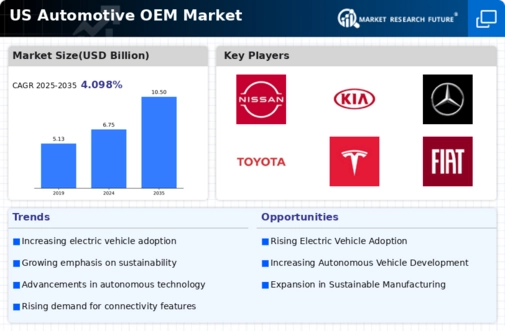The competitive insights of the US Automotive OEM Market reveal a dynamic landscape characterized by a mix of well-established legacy brands and emerging players striving to capture market share through innovative products and forward-thinking strategies. As consumer preferences evolve alongside advancements in technology, traditional automotive manufacturing experiences significant disruption, prompting companies to adapt and pivot toward electrification, sustainability, and connectivity attributes in vehicles.
The race among automotive original equipment manufacturers (OEMs) is intensified by fluctuating regulations, trade policies, and shifts in consumer demand, driving companies to reassess their value propositions and ensure they meet the evolving expectations of safety, efficiency, and experience-enhancing features. Competitive differentiation is often achieved through robust research and development investments and strategic partnerships aimed at bolstering technological capabilities, enhancing product offerings, and increasing efficiency in manufacturing processes.
Nissan has carved a notable niche in the US Automotive OEM Market with its broad range of vehicles, which includes everything from compact cars to full-size trucks, emphasizing innovation as a core strength. The company's focus on electric vehicle technology, particularly the development and promotion of its electric models, illustrates its commitment to sustainable mobility solutions that align with market demands. Furthermore, Nissan's agile production capabilities and strong dealership networks across the United States contribute significantly to its market presence. The brand also enjoys a solid reputation for safety and reliability, backed by favorable consumer perceptions and loyalty.
Nissan continues to invest in advanced technology integration within its lineup, enhancing features such as autonomous driving and connected services, positioning itself as a frontrunner in the competitive automotive landscape.Kia has gained substantial footing in the US Automotive OEM Market, known for delivering vehicles that combine style, functionality, and value. The company's key products span a diverse range, from compact sedans to robust SUVs, each designed to meet specific consumer needs. Kia's recent focus on hybrid and electric vehicle offerings also showcases its commitment to environmental responsibility, appealing to a growing segment of eco-conscious consumers.
The company has demonstrated strong brand equity within the US, leveraging a well-established distribution network that enhances customer accessibility and service. Kia's strengths lie in its high-quality manufacturing processes, competitive pricing strategies, and strategic marketing campaigns that resonate with target demographics. Additionally, through various mergers and partnerships, Kia has successfully expanded its technological capabilities, allowing for the integration of advanced driver-assistance systems. The brand’s focus on customer satisfaction and quality assurance reflects positively in its consumer ratings, contributing further to its competitive edge in the automotive market.


























Leave a Comment